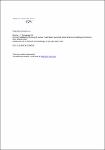Genetic variability of group A human respiratory syncytial virus strains circulating in Germany from 1998 to 2007.
Reiche, Janine
Schweiger, Brunhilde
The variability between respiratory syncytial virus (RSV) strains is one of the features of RSV infections that might contribute to the ability of the virus to infect people repeatedly and cause yearly outbreaks. To study the molecular epidemiology of RSV, more than 1,400 RSV isolates from human nasopharyngeal aspirates or nasal or throat swabs from patients with respiratory illness were identified and differentiated by TaqMan reverse transcription-PCR into groups A and B. RSV group A was dominant in seven out of nine epidemic seasons. Phylogenetic analysis revealed that RSV group A genotypes GA2 and GA5 circulated from 1998 to 2007. Genotype GA7 was present in only two seasons (1999 to 2000 and 2002 to 2003). Comparison of the synonymous mutation/nonsynonymous mutation ratios showed greater evidence for selection pressure for genotype GA2 (1.18) than for GA5 (4.34). Partial protein sequences were predicted to encode G proteins of 298 amino acids in length and in a few cases of G proteins of 297 amino acids in length. Amino acid analysis also revealed genotype-specific amino acid substitutions: two substitutions for genotype GA2, seven for GA5, and three for GA7. Two to four putative, genotype-specific N-linked glycosylation sites were determined. Predicted O-glycosylation sites included 22 to 34 residues. This study provides for the first time data on the circulation pattern of RSV group A genotypes and their molecular characterization in Germany during nine consecutive epidemic seasons.
Dateien zu dieser Publikation
Keine Lizenzangabe
Verwandte Publikationen
Anzeige der Publikationen mit ähnlichem Titel, Autor, Urheber und Thema.
-
2009-10-08ZeitschriftenartikelProgress in the surveillance of respiratory syncytial virus (RSV) in Europe: 2001-2008 Meerhoff, T. J.; Mosnier, A.; Schellevis, F.; Schweiger, BrunhildeRespiratory syncytial virus (RSV) surveillance is important to get insight into the burden of disease and epidemic pattern of RSV infection. This information is useful for healthcare resource allocation as well as the ...
-
2016-02-11ZeitschriftenartikelLong-Term Shedding of Influenza Virus, Parainfluenza Virus, Respiratory Syncytial Virus and Nosocomial Epidemiology in Patients with Hematological Disorders Lehners, Nicola; Tabatabai, Julia; Prifert, Christiane; Wedde, Marianne; Puthenparambil, Joe; Weissbrich, Benedikt; Biere, Barbara; Schweiger, Brunhilde; Egerer, Gerlinde; Schnitzler, PaulRespiratory viruses are a cause of upper respiratory tract infections (URTI), but can be associated with severe lower respiratory tract infections (LRTI) in immunocompromised patients. The objective of this study was to ...
-
2019-07-24ZeitschriftenartikelEstimation of influenza‐ and respiratory syncytial virus‐attributable medically attended acute respiratory infections in Germany, 2010/11‐2017/18 an der Heiden, Matthias; Buchholz, Udo; Buda, SilkeBackground The burden of influenza in primary care is difficult to assess, since most patients with symptoms of a respiratory infection are not tested. The case definition of “medically attended acute respiratory infection” ...

